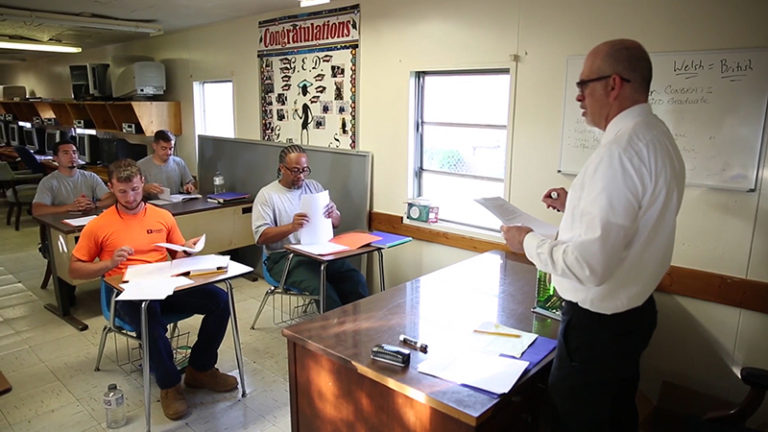Now Associate Director of UNC-CH’s Correctional Education Program at the Friday Center, Raphael Ginsberg’s decision to start teaching in local prisons as a graduate student stems from an example set by his parents, who were both public defenders. In a conversation with me over coffee, Raphael recounted how at a young age he learned that his father once had a good time teaching in a prison during law school—an idea apparently impressive enough to Raphael that it continued to “jangle around” in his head as a possibility for making a positive impact. Though his mother died when he was just a kid, Raphael speculates that seeing recorded footage of her arguing on behalf of a defendant in a trial on local TV also instilled in him a service-minded sense of the importance of advocating for prisoners, who need as much help getting an education as they need legal assistance. Jokingly referring to himself as a “true believer” (a derogatory term sometimes used by prosecutors to refer to people who blindly believe in a defendant’s cause), Raphael holds firmly that advocacy is crucial part of making the criminal justice system more equitable.
Raphael is a committed community organizer. For him, the most rewarding and important part of teaching in prisons is that the classroom becomes a space where special and much-needed bonds can form between students. Community, Raphael pointed out to me, is actively annihilated in the prison system. Everything is transient. A prisoner’s human relationships—all of them—are temporary, even as they are, at the same time, all too intimately associated with fear and hostility. In contrast, the classroom becomes a “little world” in which wisdom and learning are shared between both teacher and students.
How did you become involved with UNC’s Correctional Education Program? You have a PhD in Communication Studies from UNC. Can you describe the evolving relationship between your academic work and your current role as Associate Director for Corrections?
Halfway through my PhD work I contacted the North Carolina Department of Public Safety asking about teaching in prison. I had no specific idea of what that teaching would look like and thought it would be something I would set up on my own, but I got an email back saying “UNC-CH has a prison education program. Go talk to Brick Oettinger at The Friday Center.” It was a great stroke of luck that I ended up at one of the few schools that had such a program.
Until recently there was no relationship between my work with Correctional Education and my academic work. The articles I’ve written and my dissertation had nothing to do with prison education, and I didn’t bring any of that work into the prison classroom. In the last few years I began to think and write about prison pedagogy, including a chapter in the book Critical Perspectives on Teaching in Prison, a chapter in which some of the ways I’ve framed things in my academic work were incorporated into writing about prison teaching.
That chapter involved my experience as a teacher in prison, but my work as Associate Director has nothing to do with any academic work. But, surely, the humanities, which I completely took for granted in my education, have been very important in me understanding the world and developing rewarding ways to engage with it. People in prison do not have access to any humanities education in prison, and may never have had such access. Of course people in prison are missing out on all of the joy and power it can bring, and the rest of us are missing out on what they themselves can become and create with the humanities.
As I understand it, the Correctional Education Program offers its students all kinds of university-accredited coursework, from a variety of disciplines. That said, coming from a background in Communication Studies, how have you been able to use training in the humanities to facilitate the program?
I have ensured that the humanities is a key component of our curriculum. We bring in a cycle of four courses, one of which is an Arts and Humanities course, including Music History, Art History, and English Literature. These prove to be the key courses in our curriculum, where textual analytical skills are developed, writing approaches are refined, and students experience the joy of the communal experience of creative expression.
What is one thing you wish that more people understood about correctional education?
First, I wish people knew that teaching in prison is safe and not scary. Second, I wish people could appreciate the diversity of students in a prison classroom, diversity of every possible type, geographic, racial, political, age, and so on. Accordingly, in the prison classroom there is a diversity in linguistic styles, investments in the importance and purpose of education, and areas of expertise. Finally, I wish people could appreciate the joy in being a part of the development of a learning community, especially in a context where community of any kind is rare and forever-fraught. Yes, students earn credits and gain skills, but more than anything else it is the experience of being and learning with others that shapes the culture of each class.
Are there other public humanists whom you admire? In what ways do they inspire you, or influence how you practice the humanities?
The editors of the Journal of Prisoners on Prisons work closely with writers in prison on scholarly work; editors use their research and writing skills to improve the quality of the scholarship in a series of editorial revisions. The writers’ ideas and analysis remain central but are improved through the application of scholarly practices with which the writers are otherwise unfamiliar.
Raphael informs me that he and his team and the Friday Center are always looking for passionate teachers to join their team. Professors and graduate students who are interested in teaching in a North Carolina correctional facility should contact Raphael Ginsberg at trapido@email.unc.edu.

